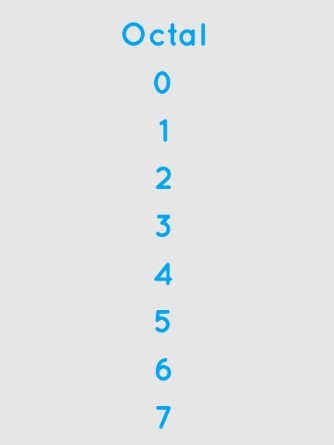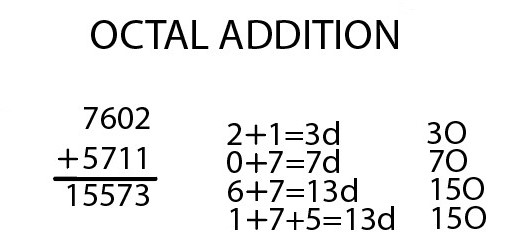Simplify octal number calculations with our Octal Math Calculator. A user friendly tool designed for accurate and efficient mathematical operations in the octal system.
RESULTS
Dealing with octal numbers can be difficult. Enter the Octal Math Calculator, a solution for tricky base-8 figures. This guide will help you use this tool.
Understanding the Octal Number System
Introducing an intriguing base-8 structure that simplifies binary code representation. This numerical language is a cornerstone in areas ranging from electronics to software development, offering a streamlined approach to complex calculations.
What Is The Octal Number System?
The octal number system is like the decimal system most people use every day, but it only goes up to 7. Imagine you have eight fingers instead of ten, and you count on them, that’s how octal numbers work.
This system counts by eights, starting with 0 to 7. After reaching 7, it resets to 10 which is an eight in our usual counting method.
In computers and electronics, octal numbers are really important because they can represent long binary values more simply. Since one octal digit can show three binary digits (bits), it helps computer programmers see big binary numbers faster and clearer.
For example, the binary number ‘110111101’ looks shorter than the octal ‘675’. So when working with digital systems or coding, knowing about the octal system can be a big help.
How Is It Used In Mathematics?
Moving from what the octal number system is, let’s explore its application in math. In computer science and digital electronics, this system plays a key role. It helps us work with binary coded decimal numbers easily.
Programmers use it to represent data in a more compact form than binary can offer. For example, three binary digits convert neatly into one octal digit. This makes reading and debugging code much simpler.
It also comes in handy for networking tasks and managing storage space on computers. Because of its relationship with the binary system—which computers fundamentally understand—octal serves as a bridge between human readable numbers and machine language.
In addition, some calculators perform arithmetic operations using octal numbers directly, allowing users quick access to convert between number systems or solve problems specific to computing fields.
Formula
To switch from octal numbers to base 10, you need a special formula. The digits of the octal number work with powers of eight. Take each digit, multiply by 8 raised to its position, and then add them all up.
For example, if you have an octal number like 1234_8, it unfolds as (1 * 8^3) + (2 * 8^2) + (3 * 8^1) + (4 * 8^0).
Using this method turns any octal into a decimal number so you can understand it in everyday math terms. This is handy for different kinds of computer science problems and coding tasks where data comes in octal form but humans need it in base 10.
Remember those powers of eight, they’re your secret tool for cracking octal calculations! Optimize your binary to octal conversions with our Binary to Octal Calculator. Streamline complex computations effortlessly for accurate results.
What Is The Octal Calculator?
An octal calculator is a powerful tool for dealing with numbers in base 8 format. Think of it as a special kind of calculator that handles numbers differently from the regular ones you use for day to day math.
Instead of counting with ten digits, this one uses only eight: 0 to 7.
The octal calculator helps in performing mathematical operations like addition, subtraction, multiplication, and division specifically in the octal number system. It’s not just about basic calculations; you can also convert between decimal, binary, and octal systems.
This comes in handy if you’re coding or doing complex computer related work where these conversions are essential. Because it’s online and free to access, anyone needing such calculations can jump right on from any device connected to the internet.
How Does It Work?
To use the octal calculator, start by entering an octal number. You’ll find a keypad, or you can type directly. Choose the arithmetic operator you need—whether it’s for addition, subtraction, multiplication, or division.
Next, input another octal number into the calculator. Once both numbers are in, simply press the calculate button. The screen will show your result in octal format right away!
This tool is not just about basic operations; it also converts between decimal and octal systems. With its user friendly interface, even complex tasks like long division become straightforward with this calculator.
Now that you know how to operate it let’s see how it makes your math work easier and more accurate. Unlock mathematical precision with our Cross Product Calculator. Seamlessly compute cross-products for accurate results.
Benefits Of Using The Octal Calculator
The octal calculator emerges as a powerful tool, streamlining complex numerical conversions and operations with precision and ease. It’s an indispensable asset for anyone in digital electronics and computer science, where the manipulation of base-8 numbers is a frequent necessity—promising accuracy without sacrificing speed.
Saves time and effort
Calculating octal numbers by hand takes a lot of time and can be tricky. The Octal Calculator changes that. It lets you do all the math fast, whether it’s octal addition, subtraction, multiplication, or division.
You just type in your numbers and pick your operation, it’s that simple. This tool is all about making things swift and stress free for anyone curious about the octal number system.
With this calculator, there’s no need to worry about making mistakes either. It handles the hard parts of problem solving in minutes so you can focus on learning or move on to other tasks quickly.
Next up: preventing errors while working with octal numbers!
Prevents Errors
Besides saving time and effort, the Octal Calculator is a crucial tool for accuracy. It gives exact answers for complex octal math problems. This reduces the chance of mistakes that can happen when doing calculations by hand.
The calculator handles every step with precision, from simple additions to more challenging operations like multiplication and division.
Manual calculations are risky because it’s easy to lose track or mix up numbers, especially with base 8 systems like octals. But with an Octal Calculator, you’re protected against these errors.
You get reliable results every time which helps in problem solving without having to double check your work constantly. Trusting this high tech helper means you can focus on learning and applying your knowledge instead of fretting about potential slip ups in your math work.
Convenient And Easy To Use
The Octal Calculator not only prevents errors but also shines in its simplicity and functionality. Its user friendly interface welcomes users of all skill levels. With just a few clicks, you can perform octal addition, subtraction, multiplication, or division.
No need to know complex formulas or spend time solving problems on paper.
Anyone from students to professionals can use the calculator with ease. It’s designed for quick learning, just enter your numbers, choose an operation, and get immediate results. This tool streamlines calculations in binary form or when dealing with base 2 and base 16 systems as well.
Working with octal numbers becomes straightforward and hassle free, boosting productivity for anyone tackling math in education or tech fields. Transform your hexadecimal calculations with our Hex Calculator. Seamlessly navigate complex computations for precise results.
Step by step Guide On How To Use The Calculator
Calculating with octal numbers can be tricky, but an octal math calculator makes it easy. Here’s a simple guide to using one:
- Enter your first octal number into the calculator. This is the starting point of your calculation.
- Choose the math operation you need – subtraction, addition, division, or multiplication.
- Input your second octal number. This is the other important part of your equation.
- Press the calculate button to get your answer.
- Look at the screen to see your result displayed right there.
Examples
Let’s say you have two octal numbers: 125 and 7. You want to add these numbers together. Enter 125 into the Octal Math Calculator first, then press the “+” sign for an addition operation.
Next, put in the number 7 and click “calculate.” The calculator will quickly show you that the sum is 134 in octal form.
If subtraction is what you need, imagine having the octal numbers 701 and 256. First, type in 701 as your minuend—this is the number from which you subtract. Then hit the “-” button to choose subtraction and enter 256 as your subtrahend—the amount being taken away.
Press “calculate,” and right away, it tells you that when you take away 256 from 701 in octal math, what’s left over (the difference) is 423.
Times for multiplication? No problem! Suppose your teacher asks for a product of two octal numbers: multiply them using our calculator with ease! Type in one multiplicant like maybe it’s an easy one: just ‘3’.
Choose “x” for multiplication next; let’s make this tough, throw a big number at us.. how about ‘174’? Hit “calculate” now – watch the magic happen, ‘522’ pops out right on the screen!
And don’t forget division! With remainders sometimes tricky to figure out by hand – use our tool instead! Start with any dividend (that’s a fancy term for something divided), like perhaps ‘1444’.
Pick “÷” next; split this giant downsize by dividing against something smaller – could be ‘2’. Punch that “calculate” quickly — voilà — results are clear as day: the exact quotient here reads ‘622’, tidy and true without lifting more than a fingertip.
For each operation, whether adding or taking bits off; making things bigger (multiply!) or slicing into pieces (divide!), trusty Octal Math Calculator zips through problems fast so kids can ace quizzes without breaking a sweat! Master precision in calculations with our Factorial Calculator. Effortlessly compute factorials for accurate results.
FAQs
1. Is there a limit to the number of numbers I can input?
The calculator’s limits depend on the implementation. Most calculators can handle reasonably large octal numbers, but extremely large numbers may exceed the capabilities of the calculator.
2. Can I perform bitwise operations with the Octal Math Calculator?
No, the Octal Math Calculator focuses on arithmetic operations. Bitwise operations are not supported.
3. How do I add two octal numbers using this calculator?
To add two octal numbers, you need an augend, that’s your first number, and an addend, the second number you want to add. Put them into the calculator, hit the plus button, and see how it adds up perfectly!
4. Can a calculator for octal handle big multiplication problems too?
Of course! If you’ve got tough multiplication with lots of digits in those quirky octals, punch them into your trusty calculator, it’ll multiply them quickly as a wink.
Related Calculators:


